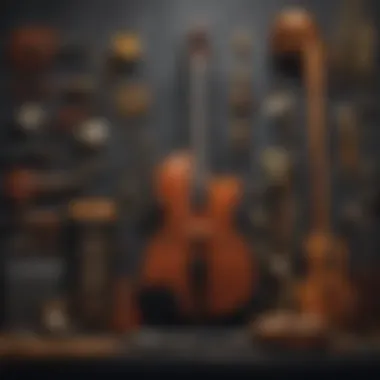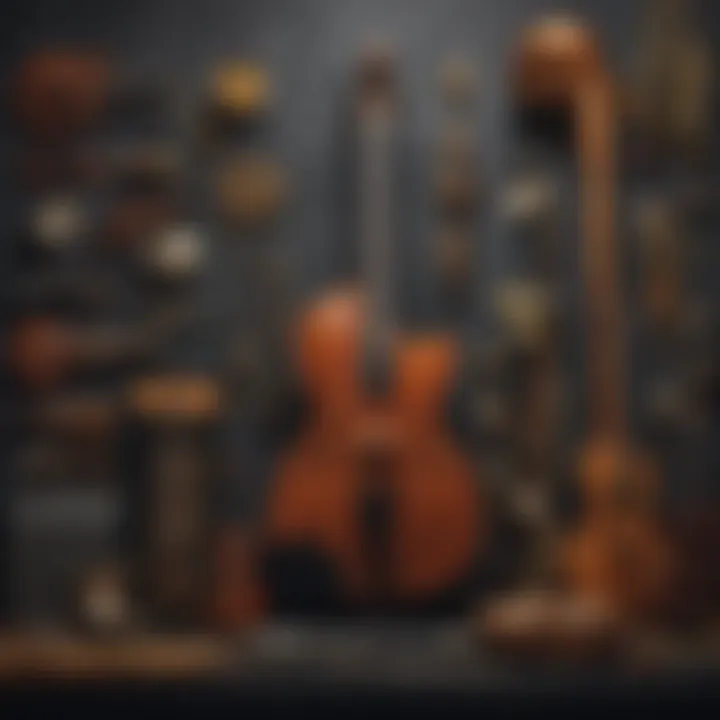The Healing Power of Music: An In-Depth Analysis


Intro
Music possesses an innate ability to connect with the human experience. It transcends language, culture, and time, serving not just as entertainment, but as a profound form of healing. The concept of being "anointed to heal" suggests a divine or inherent power within certain musicians to channel this healing essence through their art. This article delves into the symbiotic relationship between music and healing, unraveling how melodies and harmonies can evoke emotional responses that facilitate personal and communal healing.
Through a thorough exploration of various artists and genres, we aim to provide insights into the ways music resonates with audiences. From therapeutic applications in clinical settings to its role in cultural movements, the nuances of music as a healing force deserve attention.
Artist Profile
Biography and Background
Many artists across different genres can be considered healers in their own right. Their lives often reflect struggles, triumphs, and revelations that resonate deeply with listeners. For example, the musician Björk integrates her Icelandic roots into her work, using her unique voice and experimental music to address themes of nature, identity, and emotional resilience. Her journey and artistry create a rich backdrop that enhances the healing aspects of her music.
Major Influences and Inspirations
The influences on an artist's work often shape their healing capabilities. Björk, influenced by personal experiences and eclectic soundscapes, crafts music that invites introspection and deep emotional connections. Other artists like Bob Marley have drawn from socio-political contexts, using reggae rhythms and poignant lyrics to address issues of love, unity, and struggle, which inherently speaks to the human soul's need for solace and understanding.
Song Analysis
Theme and Lyrics Breakdown
When analyzing individual songs, the themes can vary widely. For instance, Marley's song "One Love" conveys messages of unity and peace, displaying how music can channel collective healing. Meanwhile, Björk’s "Human Behaviour" explores human instincts and emotions, prompting listeners to confront their inner selves and experiences.
Each lyric serves a purpose, whether to comfort, challenge, or inspire.
Instrumentation and Composition
The instrumentation plays a crucial role in enhancing the healing experience. For example, the fusion of electronic sounds with traditional instruments in Björk's works creates a unique sound landscape. This interplay invites listeners into an immersive auditory journey. Similarly, the use of reggae's offbeat guitar and rhythmic bass in Marley's songs evokes feelings of joy and resilience. The arrangement and layers in music contribute significantly to its emotional impact, thus fortifying its healing power.
Music can heal, transform, and inspire. It is more than just sound; it is a lifeline.
In summary, by examining the profiles of influential artists, the themes within their works, and the intricacies of their musical compositions, we can better appreciate the depth of music's healing properties. This comprehensive understanding highlights music not only as an art form but as a vital component of the human experience.
Understanding the Concept of Anointment in Music
The notion of anointment in music is critical to understanding how certain artists and their work profoundly touch the lives of their listeners. It captures the essence of someone being chosen or destined to convey messages of healing, whether through lyrical content, melody, or cultural resonance. In this examination, anointment in music connects to the idea that some artists carry a unique responsibility to impact their communities while providing solace and guidance through their art. The exploration of this concept encourages readers to consider how musical expression can activate processes of healing in both personal and social contexts.
Defining Anointment
Anointment in music refers to the perceived blessing of artists who use their talents to promote healing. This can manifest in various ways, from the emotional depth of their lyrics to the soothing quality of their melodies. Artists like Bob Marley and Nina Simone are examples where their music serves as a vessel for healing social issues or personal struggles.
Anointed artists often possess a special connection with their audience, creating a profound emotional experience. This connection facilitates a deeper listening experience that resonates with individuals on an intimate level.
Historical Context of Anointed Artists
The concept of anointment is not new; it has roots in various musical traditions throughout history. Many cultures have recognized individuals whose voices carry spiritual or transformative significance. Historical figures, such as Aretha Franklin, often referred to as the "Queen of Soul," exemplify this quality. Her music provided a soundtrack to the civil rights movement, affirming her anointed status in addressing social injustices.
Moreover, various musical genres, like gospel and folk, have long incorporated themes of spiritual healing. Artists in these genres are often seen as conduits of a higher calling, where their work influences collective healing in communities.
Spiritual and Cultural Connotations
Anointment in music encapsulates both spiritual and cultural layers. For many, music serves as a sacred medium, allowing listeners to connect with something larger than themselves. This transcendent experience is crucial in various spiritual traditions across the globe.
Culturally, the concept of being anointed contributes significantly to the identity of certain music styles. Genres like reggae often intertwine with themes of peace and love, emphasizing the importance of a communal healing process. This connection to culture and spirituality enhances the understanding of how music operates within the realm of healing.
In summary, anointment in music is a tangible thread linking artists, their work, and the healing journeys of listeners. This concept invites a deeper investigation into how music not only serves as a reflection of cultural experiences but also as a vehicle for personal and collective healing.
Music as a Form of Healing
Music has long been acknowledged not just as an art form but also as a profound medium of healing. Its significance lies in the ability to evoke emotions, trigger memories, and bring about psychological change. This section will dissect how music functions as a form of healing by exploring its therapeutic applications, emotional resonance, and specific case studies that highlight its efficacy.
Therapeutic Applications of Music


The clinical utilization of music as a therapeutic tool spans a variety of settings.
- Music Therapy: This is often conducted by trained professionals who use music to address physical, emotional, cognitive, and social needs. Individuals facing mental health issues, such as anxiety or depression, often experience relief through structured musical interventions.
- Pain Management: Numerous studies have shown that music can reduce the perception of pain. For example, listening to preferred music can distract from pain and ease stress during medical procedures.
- Rehabilitation: Music is used in rehabilitation settings to improve motor and cognitive functions. Patients recovering from strokes or brain injuries often respond positively to rhythmic auditory cues.
Music's role in therapeutic practices showcases its versatility, enabling it to adapt and integrate into various treatment plans with efficacy and compassion.
Emotional Resonance in Music
The emotional qualities inherent in music trigger deep responses within individuals. Music has the capability to connect on a personal level, allowing listeners to experience a spectrum of emotions, from joy to sorrow. This emotional resonance serves several functions.
- Catharsis: Engaging with music can provide a release for pent-up emotions. Listeners may find an easier outlet for grief or anxiety while immersed in songs that speak to their experiences.
- Mood Regulation: Many individuals employ music as a tool for mood enhancement. Upbeat genres can uplift spirits, while slower melodies often provide comfort.
- Connection and Community: Attending concerts or sharing music can generate feelings of belonging. The collective experience of music fosters social bonds that can be immensely healing in nature.
"Music can change the world because it can change people." – Bono
The emotional engagement with music illustrates its capacity to serve as a balm for psychological turmoil and societal disconnection.
Case Studies in Music Therapy
Investigating specific situations where music therapy has made a significant impact underlines its potential.
One notable case is that of a young boy with autism who had difficulty communicating. Through music therapy sessions, he began to vocalize and express himself in ways that verbal communication had previously failed to accomplish. His progress underlined how music can facilitate communication, fostering a sense of understanding and connection.
Another example might include a group therapy session for veterans suffering from PTSD. Here, music therapy has been employed to create a safe space where shared experiences are expressed. Participants process their trauma through lyric discussion and musical expression, promoting recovery and healing.
These case studies highlight how music is not just an abstract concept but a practical solution in diverse therapeutic environments. Each serves as a testament to the versatile strength of music in fostering healing and emotional well-being.
Cultural Perspectives on Healing through Music
Understanding the relationship between culture and music is crucial when examining how music serves as a healing tool. Different cultures have unique musical traditions that reflect their values and beliefs. These traditions influence how music is perceived, produced, and utilized for healing purposes. Each cultural perspective brings distinct insights into how individuals use music to cope with emotional pain, physical ailments, or spiritual distress.
The integration of music into healing practices is not merely a modern phenomenon. Across time, several societies have employed sound in rituals to facilitate recovery. Music acts as a universal language that can convey emotions. It creates an environment conducive to healing by fostering connection, community, and a shared experience among individuals. When discussing cultural perspectives on healing through music, it is essential to explore specific elements that contribute to this phenomenon.
Traditional Healing Practices and Music
Traditional healing practices often incorporate music as a central component. In many Indigenous cultures, rituals aimed at addressing illness include songs that are believed to channel positive energy. For example, the use of drumming in Native American ceremonies serves to connect the participants to spiritual realms, reinforcing the belief that music directly influences health and well-being.
In various African communities, music plays a role in rituals designed to address both physical and mental ailments. Healing ceremonies often include songs, dances, and rhythmic patterns that invigorate the participants, promoting emotional release and healing. Similarly, in India, traditional practices like Ayurveda use ragas, specific musical scales associated with various times of the day, believed to harmonize the body and mind.
Contemporary Views on Music and Wellness
In modern societies, the trajectory of understanding music’s role in wellness has evolved. The contemporary perspective embraces evidence-based practices, viewing music therapy as an integral component of holistic healing approaches. During therapy sessions, trained professionals use music for its therapeutic effects, addressing a range of conditions, from anxiety to chronic pain.
Research indicates that listening to music can decrease stress-related responses and improve overall psychological health. Facilities like hospitals and rehabilitation centers increasingly implement music therapy programs. This shift acknowledges the ever-growing body of evidence supporting music’s capacity to foster emotional and mental well-being.
Global Perspectives on Musical Healing
Globally, different cultures continue to recognize the psychological and physiological benefits of music. In Western cultures, genres such as classical and jazz have been researched for their calming effects, while cultures in Asia may focus on the use of traditional instruments like the sitar or the kuchipudi dance form to represent and facilitate healing.
In Japan, the practice of "Naikan" therapy incorporates music to promote self-reflection and personal insight, showing how diverse cultures adapt musical healing to fit their societal norms.
The Role of Iconic Artists in Healing through Music
The influence of iconic artists in the realm of music and healing cannot be overstated. These musicians have a unique ability to connect deeply with the human experience through their art. Their works resonate not just on a superficial level but tap into emotional and psychological states that facilitate healing. Many artists have utilized their platforms to convey messages of resilience, hope, and strength. This aspect makes their role crucial in modern society, where mental health awareness is increasingly important.
Profiles of Influential Artists
Identifying key artists who have contributed significantly to the healing power of music is essential. For instance, Bob Marley used reggae as a medium to address issues of social justice and personal empowerment. His songs such as "One Love" encourage unity and collective healing, transcending personal grievances. Similarly, Adele’s ballads often explore themes of heartbreak and emotional release, allowing listeners to confront their feelings in a safe space. Moreover, Beyoncé has been a powerful voice for empowerment, addressing racial and gender issues, which fosters healing within communities facing oppression. Each of these artists brings a unique perspective that helps to articulate experiences many people go through, thus creating a therapeutic environment for listeners.
Impact of Lyrical Content on Healing
The lyrics of songs play a pivotal role in the healing journey of individuals. Thoughtful lyrics can validate listeners’ feelings and experiences. For example, Terrance Blanchard’s jazz compositions often integrate narratives of struggle and recovery, inviting listeners to engage in their own healing process. The emotional weight carried in the words can spark reflection, catharsis, and ultimately, healing.
Understanding the lyrical storytelling is crucial. Lyrics can serve as affirmations or cries for help, making them a source of comfort for those in pain. Songs with messages of hope can offer strength during difficult times. Moreover, artists like Kendrick Lamar tackle mental health topics head-on, sparking conversations that reduce stigma and promote understanding. Thus, lyrical content serves as both a mirror and a guide in the healing process.


Artist Activism and Community Healing
The commitment of artists to activism further supports the concept of music as a healing force. Artists such as Chance the Rapper and Leonard Cohen have used their celebrity status to address issues impacting their communities. Chance’s outreach in schools and advocacy for mental health initiatives symbolizes how artists can leverage their influence for healing on a communal scale.
In addition, during crises, artists often band together for benefit concerts, raising awareness and funds for pressing issues. Events like Live Aid and various relief concerts illustrate the way music fosters solidarity and healing. In these moments, music becomes a tool not just for individual relief but for fostering a community spirit, reminding individuals they are not alone in their struggles.
Music has the power to heal by touching every corner of the human experience. Iconic artists harness this power to uplift, encourage, and advocate for change within themselves and society.
Exploring Genres that Heal
The exploration of various music genres that have healing properties is essential in understanding the broader concept of music as a healing medium. It highlights how different styles resonate with listeners and can foster emotional well-being. Each genre brings unique qualities that can impact mental, emotional, and even physical health. The benefits of engaging with these genres are substantial, offering therapeutic options that cater to diverse needs and preferences.
- Therapeutic diversity: Each genre contributes to a wider array of therapeutic practices.
- Emotional connection: Listening to specific music can evoke powerful emotions, bridging gaps between experience and expression.
- Cultural significance: Genres often have deep-rooted cultural contexts that influence their healing qualities.
Understanding these elements allows music enthusiasts, aspiring musicians, and students to appreciate how genres like classical, blues, gospel, and world music can be leveraged for healing purposes.
The Soothing Power of Classical Music
Classical music has long been associated with relaxation and tranquility. Composers such as Johann Sebastian Bach and Wolfgang Amadeus Mozart have created pieces that are not only technically advanced but also emotionally soothing. The structured nature of classical compositions engages the mind while promoting feelings of peace.
Research has shown that classical music can reduce anxiety, lower heart rates, and even improve sleep quality. The soothing melodies and harmonies often induce a state of mindfulness, allowing listeners to escape from stress and immerse themselves in a more tranquil atmosphere. As such, classical music serves as an essential tool in therapeutic settings, such as hospitals and wellness centers, where recovery and stress relief are paramount.
The Raw Emotion of Blues and its Healing Properties
The blues genre, derived from African American spirituals and work songs, embodies human suffering and resilience. Artists like B.B. King and Muddy Waters convey deep emotions through their music, often reflecting personal stories of hardship and perseverance. The raw emotion inherent in blues can resonate with listeners, providing a sense of understanding and acceptance of their own struggles.
Engaging with the blues allows individuals to process feelings of sadness, loss, or heartache. The cathartic nature of this genre enables listeners to confront their emotions and find solace in shared experiences. Furthermore, the improvisational elements characteristic of blues may empower musicians to express themselves authentically, which can also be healing both for artists and audiences alike.
The Uplifting Nature of Gospel Music
Gospel music stands out for its uplifting and inspiring messages. Rooted in African American Christian traditions, this genre captivates audiences with powerful vocals and rich harmonies. Artists like Aretha Franklin and Mahalia Jackson have brought gospel music to the forefront, instilling hope and spiritual connection in their listeners.
The themes present in gospel music speak to resilience, faith, and redemption, fostering a sense of community and belonging. The act of singing or listening to gospel can elevate moods and create a profound sense of joy. Notably, gospel music often plays a vital role in therapeutic practices, such as group therapy settings, where collective participation enhances emotional healing and reinforces social bonds.
World Musics and Their Therapeutic Qualities
World music encompasses a rich tapestry of musical styles originating from various cultures. Each genre carries distinct therapeutic qualities, informed by the cultural context from which it arises. For instance, Indian classical music, characterized by raga, emphasizes emotional expression and spirituality, while African drumming creates a sense of community and connection.
Engaging with world music allows for a broader understanding of healing practices across cultures. The rhythmic patterns, melodies, and instrumentation evoke different emotional responses, promoting relaxation or energizing listeners, depending on the genre. By integrating world music into healing practices, individuals can experience a diversity of therapies that encourage personal growth, understanding, and global consciousness.
Science and Research on Music and Healing
The connection between music and healing is increasingly supported by empirical evidence and scientific inquiry. This section examines the significance of research in this field. Understanding how music engages the brain and influences emotional well-being sheds light on its therapeutic capabilities. Musicians, therapists, and health professionals can benefit from the insights derived from scientific findings, making the integration of music into healing practices more effective.
Neuroscientific Insights into Music Perception
Neuroscience has made significant strides in understanding how music is processed by the brain. Studies show that music engages multiple brain regions. It influences emotions, cognition, and even physiological responses. For instance, the auditory cortex, which interprets sound, works closely with the limbic system, responsible for emotional reactions. This means the act of listening to music can evoke powerful feelings and memories.
Research utilizing brain imaging technology demonstrates that music can activate the reward centers of the brain. This indicates that pleasurable music can release dopamine, a neurotransmitter associated with feelings of enjoyment and happiness. Moreover, rhythmic elements in music can synchronize with our bodily rhythms, influencing heartbeat and respiration rates. This has profound implications for music therapy practices, illuminating its potential for stress reduction and anxiety alleviation.
Empirical Studies Linking Music to Healing Outcomes
Numerous empirical studies have linked music to positive health outcomes across various contexts. Research shows that patients who listen to music during surgery report less pain and anxiety. In rehabilitation settings, music therapy has been associated with improved motor skills and cognitive function in stroke survivors. Additionally, hospitals often use music in intensive care units to enhance patient comfort and recovery.
A meta-analysis of clinical trials indicates that music positively impacts physical and psychological health. For example:
- Pain Management: Music significantly reduces pain perception among patients undergoing medical treatments.
- Mental Health: Music therapy decreases symptoms of depression and anxiety in various populations.
- Cognitive Benefits: Individuals with dementia show improved mood and social interaction when exposed to familiar music.
The findings highlight music’s role not just as entertainment but as a genuine therapeutic intervention, enhancing well-being and recovery.
The Biopsychosocial Model of Music Therapy
The biopsychosocial model is an important framework in healthcare that considers biological, psychological, and social factors in patient care. In the context of music therapy, this model recognizes that music can address diverse aspects of an individual’s health.


Biological Factors: These pertain to the physiological effects of music, such as changes in heart rate, blood pressure, and stress hormone levels. Certain genres or compositions can induce relaxation, benefiting patients physically.
Psychological Factors: Music can evoke emotions and memories, providing a means of expression and processing for individuals. This aspect is crucial in therapeutic settings, allowing patients to explore feelings they may struggle to articulate.
Social Factors: The communal aspect of music should not be overlooked. Group music-making fosters connections, promoting social interaction and community healing. Therapy sessions often involve group settings where individuals share experiences and reinforce social bonds.
In summary, the integration of music into healing practices is supported by scientific research, offering insights into how music interacts with our biology and psychology. These approaches form a basis for enriching both clinical and personal applications of music in healing.
Integrating Music into Modern Healing Practices
Integrating music into modern healing practices is an area of growing significance in both healthcare and therapeutic settings. Music has shown various benefits that can enhance physical, emotional, and spiritual well-being. Many practitioners in holistic fields incorporate music therapy to support healing and recovery. This integration recognizes music not only as an art form but also as a healing mechanism that interacts with psychological and physiological processes.
The Role of Music in Holistic Therapies
In holistic therapies, music plays a pivotal role. It promotes relaxation and stress reduction. During sessions, calming music can help patients achieve a meditative state. This state fosters a connection between the mind and body, which is essential for healing. Additionally, music therapy can assist in pain management. The presence of music can distract patients from discomfort, enhancing their overall treatment experience.
Several modalities use music:
- Guided Imagery with Music (GIM): In this method, therapists use music to evoke imagery, encouraging relaxation and self-exploration.
- Active Music Making: Patients engage in playing instruments, which can improve motor skills, social interaction, and emotional expression.
- Listening Therapy: Listening to curated playlists tailored to individuals can aid in emotional processing. It balances emotional states and helps in developing coping strategies.
Developing Personal Soundtracks for Wellness
Personal soundtracks for wellness emphasize the importance of individual preferences in music selection. Each person resonates with different genres and songs, affecting their mood and well-being. By creating personalized playlists, individuals can navigate their emotions more effectively.
Some advantages of personal soundtracks include:
- Enhanced Mood: Listening to favorite songs can lift spirits and reduce anxiety.
- Ritualization of Healing Practices: Soundtracks can be embedded in self-care rituals, making the healing process more intentional and personal.
- Accessibility: Many platforms, like Spotify or Apple Music, provide easy access to creating and sharing playlists.
To develop a personal soundtrack:
- Identify emotional needs and select music that reflects or uplifts these emotions.
- Create a diverse playlist that includes calming tunes, empowering anthems, and thought-provoking tracks.
- Use the soundtrack during meditation, yoga, or other wellness activities to deepen the experience and enhance emotional response.
Future Directions in Music and Health Integration
The future of music integration in health practices looks promising. With advancing technology, new methods to harness the therapeutic properties of music are emerging. This includes the use of virtual reality combined with music therapy to create immersive healing environments.
Moreover, ongoing research continues to validate the effectiveness of music therapy. Collaborations between musicians and healthcare professionals are likely to provide greater insights into developing innovative therapeutic interventions. More interdisciplinary programs are expected to arise, emphasizing the role of music in healthcare.
The potential for music and health integration extends to wider applications:
- Health Education: Music can be used to aid in patient education by making information more memorable.
- Community Engagement: Group music sessions can promote social cohesion and mental health support, fostering community-driven initiatives.
"Music is a universal language that transcends barriers, offering a pathway to healing that is both personal and collective."
In summary, integrating music into modern healing practices is not just beneficial but essential. It highlights the multifaceted role that music plays in enhancing overall well-being. As research continues and awareness grows, the potential of music as a healing force will only expand.
Finale: The Enduring Legacy of Music in Healing
Music's importance as a healing force cannot be overstated. It has transcended its role as mere entertainment. Music shapes emotional landscapes and acts as a catalyst for healing in both personal and collective contexts. The profound connections between individuals and music emphasize its intrinsic value in welfare and emotional recovery.
In our examination, we reveal multiple aspects that underline this legacy. Music serves as an accessible form of therapy that promotes emotional well-being. It influences memory recall and stimulates neurological responses that contribute to healing processes. Its ubiquitous presence enables music to bridge cultural divides and create shared experiences.
Reflecting on Music’s Role in Personal and Collective Healing
Music plays a vital role in personal healing journeys. For individuals coping with trauma, depression, or anxiety, a carefully curated playlist can evoke comfort and solace. The types of melodies chosen often resonate with the personal experiences of the listener, creating a sense of validation and understanding. Emotional expression through music assists not only in processing feelings but also in connecting with others.
Collectively, music initiates a profound sense of community and shared healing. Events like concerts and festivals foster unity and provide spaces where individuals can come together, share stories, and heal as a group. For instance, traditional ceremonies across cultures often include music as an essential component to promote healing. It is a communal language that transcends barriers and forms bonds among diverse groups.
The Future of Music as a Healing Medium
The future of music's role in healing appears promising. With advancements in technology and science, the integration of music therapy into clinical settings is on the rise. Interactive platforms might offer personalized music experiences aimed at specific healing needs. Already, pioneering applications and software are designed to track emotional responses to different compositions.
Moreover, the recognition of music therapy by health professionals is gradually increasing. This acknowledgment opens doors for further research that could enhance therapeutic techniques and develop new methodologies.
Ultimately, music's legacy as a healing medium will continue to evolve, reflecting changes in societal perceptions and technological advancements. As new generations embrace music, its role in healing will adapt but remain a fundamental aspect of our humanity.
"Music is like a dream. One that I cannot hear but can only see." - Anonymous
Through this exploration, we see that the link between music and healing is rich and intricate. Embracing this connection can lead to a brighter future where music remains a significant player in nurturing health and wellness.







